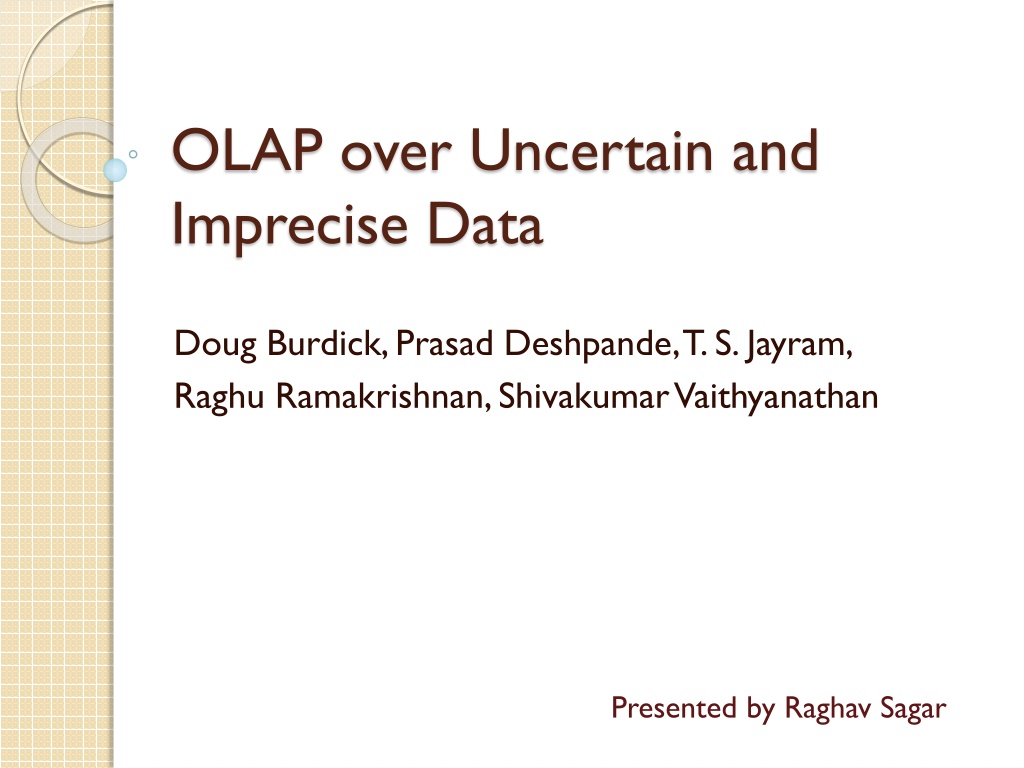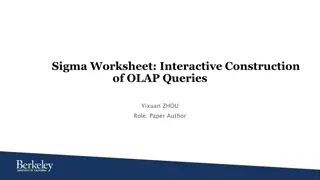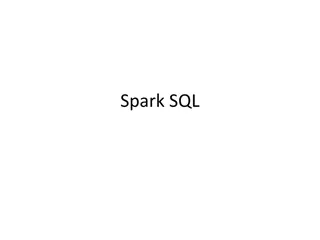OLAP over Uncertain and Imprecise Data
OLAP (Online Analytical Processing) allows interactive analysis of data with multidimensional models, categorizing measures by dimensions. The motivation is to generalize OLAP models for imprecise dimension values and uncertain measure values, addressing ambiguous data through answer aggregation queries over uncertain and imprecise domains.
Download Presentation

Please find below an Image/Link to download the presentation.
The content on the website is provided AS IS for your information and personal use only. It may not be sold, licensed, or shared on other websites without obtaining consent from the author. Download presentation by click this link. If you encounter any issues during the download, it is possible that the publisher has removed the file from their server.
E N D
Presentation Transcript
OLAP over Uncertain and Imprecise Data Doug Burdick, Prasad Deshpande, T. S. Jayram, Raghu Ramakrishnan, ShivakumarVaithyanathan Presented by Raghav Sagar
OLAP Overview Online Analytical Processing (OLAP) Interactive analysis of data, allowing data to be summarized and viewed in different ways in an online fashion Databases configured for OLAP use a multidimensional data model: Measures Numerical facts which can be measured, aggregated upon Dimensions Measures are categorized by dimensions (each dimension defines a property of the measure)
Motivation Generalization of the OLAP model to addresses imprecise dimension values and uncertain measure values Answer aggregation queries over ambiguous data
Definitions Uncertain Domains An uncertain domain U over base domain O is the set of all possible probability distribution functions over O Imprecise Domains An imprecise domain I over a base domain B is a subset of the power set of B with I. (elements of I are called imprecise values) Hierarchical Domains A hierarchical domain H over base domain B is defined to be an imprecise domain over B such that H contains every singleton set. For any pair of elements h1, h2 H, h1 h2 or h1 h2 = .
Definitions Fact Table Schemas A fact table schema is <A1, A2, .. , Ak; M1, .. , Mn> where Ai are dimension attributes, i {1, .. k} Mj are measure attributes, j {1, .. n} Cells A vector <c1, c2, .. , ck> is called a cell if every ci is an element of the base domain of Ai , i {1, .. k} Region Region of a dimension vector <a1, a2, .. , ak> is the set of cells reg(r) denotes the region associated with a fact r
Definitions Queries A query Q over a database D with schema <A1, A2, .. , Ak; M1, .. , Mn> has the form Q(a1, .. , ak; Mi, A), where: a1, .. , ak describes the k-dimensional region being queried Mi describes the measure of interest A is an aggregation function Query Results The result of Q is obtained by applying aggregation function A to a set of 'relevant' facts in D
Finding Relevant Facts All precise facts within the query region are naturally included Regarding imprecise facts, we have 3 options: None Ignore all imprecise facts Contains Include only those contained in the query region Overlaps Include all imprecise facts whose region overlaps
Aggregating Uncertain Measures Aggregating PDFs is closely related to opinion pooling (provide a consensus opinion from a set of opinions) LinOp( ) provides a consensus PDF ? which is a weighted linear combination of the pdfs in ? ? = ? ??? ?(?)
Consistency -consistency A query Q is partitioned into Q1, .. Qp s.t. reg(Q) = i reg(Qi) reg(Qi) reg(Qj ) = for every i j Satisfied w.r.t to A if predicate (q, q1, .. qp) holds for every database D and for every such collection of queries Q, Q1, .. Qp
Consistency Sum-consistency ? = ??? Notion of consistency for SUM and COUNT Boundedness-consistency min ? ? Notion of consistency for AVERAGE Consequences Contains option is unsuitable for handling imprecision, as it violates Sum-consistency ?? ? max ??
Faithfulness Measure Similar Databases (D and D ) D is obtained from Database D by modifying (only) the dimension attribute values Identically Precise Databases (D and D ) For a query Q, facts r D and r D , either: Both reg(r) and reg(r ) are contained in reg(Q) Both reg(r) and reg(r ) are disjoint from reg(Q) Basic faithfulness Identical answers for every pair of measure-similar databases D and D that are identically precise with respect to Q
Faithfulness Consequences None option is unsuitable for handling imprecision, as it violates Basic faithfulness for Sum and Average Partial Order ? IQ(D, D ) is a predicate which holds when D and D are identical, except for a single pair of facts r D and r D reg(r ) = reg(r) c c reg(Q) reg(r). Partial order ? is reflexive, transitive closure of IQ
Faithfulness -faithfulness Satisfied w.r.t to aggregate A if predicate (q1, .. qp) holds for a set of databases and query Q, with: D1 ?D2 ?.. Dp Sum-faithfulness If Di ?Dj, then ??? ???
Possible Worlds Possible Worlds of an imprecise Database D, is a set of true databases {D1, D2, .. Dp} derived by D
Extended Data Model Allocation For a fact r in database D, cell c reg(r) Probability that r is completed to c = ??,? ? ???(?)??,?= 1 If there are k imprecise facts in D, (r1, .. rk) Weight of possible world D , w = ?=1 For all possible worlds {D1, .. Dm}, ?=1 Procedure for assigning ??,? is referred to as an allocation policy Allocated Database D* contains another table with schema : <Id(r), r, c, ??,?> ? ???,?? ???= 1
?? 1,3 ,?9= 0.3 ?? 2,3 ,?9= 0.7 ?? 3,3 ,?10= 0.4 ?? 3,4 ,?10= 0.6 ?1= 0.3 0.4 ?2= 0.3 0.6 ?3= 0.7 0.4 ?4= 0.7 0.6
Summarizing Possible Worlds Consider possible worlds (D1, .. Dm) with weights (w1, .. wm) Query Q s answer is a multiset (v1, .. vm), then we have answer variable Z P Z = ?? = ?,??=???? ,?,? {1,..?} Basic faithfulness is satisfied by ?[?] But the no. of possible words(m) is exponential ? = ??? ??= ???????????(??)
Summarizing Possible Worlds Definitions: Set of cells to which fact r has positive allocations ? ? = ? ??,?> 0} Set of candidate facts for the query Q ? ? = ? ? ? ? } ,? = ???(?) For a candidate fact r, Yr is the 0-1 indicator random variable ? ??= 1 = ? ? ? ???,? ? ?? is the allocation of r to the query Q ? ?? = ? ??= 1
Summarizing Possible Worlds Step 1 Identify the set of candidate facts r R(Q) Compute the corresponding allocations ? ??to Q Step 2 Apply aggregation as per the aggregation operator (this step depends on operator type)
Summarizing Possible Worlds Sum ? = ???(?)?? ?? ?[?] satisfies Sum-consistency ?[?] does not guarantee -faithfulness for arbitrary allocation policies Monotone Allocation Policy Database D and D are identical, except for a single pair of facts r D and r D , reg(r ) = reg(r) c* ??,? ??,? ,? ? This allocation policy guarantees -faithfulness for Sum
Monotone Allocation Policy: ??,? ??,?
Summarizing Possible Worlds Average ???(?)?? ?? ???(?)?? ? = n = Partially allocated facts, m = Completely allocated facts ? ? ~ ? ? + ?3 Satisfies Basic-faithfulness Violates Boundedness-Consistency
Summarizing Possible Worlds Approximate Average ?[ ??? ??? ??] ?[ ???(?)??] ? ? ~ ? ? + ? ? ? ? ? , ? ? Satisfies Basic-faithfulness Satisfies Boundedness-Consistency ? =
Expectation of Average violates Boundedness-Consistency
Summarizing Possible Worlds Uncertain Measures Consider possible worlds (D1, .. Dm) with weights (w1, .. wm) W(r) is set of i s s.t. the cell to which r is mapped in Di belongs to reg(Q) ???(?) ???(?)?? ?? ???(?) ???(?)?? Distribution ?is called AggLinOp ? =
Allocation Policies Dimension-independent Allocation Suppose ??? ? = ?1 ?2 ?? ? ? ? ?? ??? , ??????? = 1 ? = ?1,?2, ??, ??,?= ???(??) Uniform Allocation Policy ???,?= ???,? , ? ??,??? ?, ?? ?? Dimension-independent and monotone allocation policy No. of cells with positive allocation becomes very large for imprecise facts with large regions
Allocation Policies Measure-oblivious Allocation Given database D, database D is obtained from D, s.t. only measure attributes are changed Allocation to D and D is identical Count-based Allocation Policy Nc denote the number of precise facts that map to cell c ??,?= ? ? ???(?)?? Measure-oblivious and monotone allocation policy Rich gets richer effect ??
Allocation Policies Correlation-Preserving Allocation Correlation Dist = ???? ?0, ??? ???? ?? Allocation policy A is correlation-preserving if for every database D, the correlation distance of A w.r.t D is the minimum Specifically Correlation Dist = ????0, ??? ?? ??? : Kullback-Leibler divergence ??= ???? ?? ,? ? {0,1, ,?} ???? is a PDF over dimension and measure attributes (?1,?2, ??,?)
Allocation Policies Uncertain Domain ? ???(?)?? |??? ? |) Likelihood Function : ????(??, Expectation Maximization E-step : For all facts r, cells c reg(r), base domain element o ???(?) ? ? ?,? = ? ???(?)?? ?(?) M-step : For all cells c, base domain element o ?:? ???(?)??? ?(?|?,?) ? ?:? ???(?)??? ?(?|?,? ) ?+1? = ??
Allocation Policies Calculating parameters ?? ? ? ?? ? ??(?) ??,?= ? ? ? ?
Experiments Scalability of the Extended Data Model
Experiments Quality of the Allocation Policies
Conclusion Handling of uncertain measures as probability distribution functions (PDFs) Consistency requirements on aggregation operators for a relationship between queries on different hierarchy levels of imprecision Faithfulness requirements for direct relationship between degree of precision with quality of query results Correlation-Preserving requirements to make a strong, meaningful correlation between measures and dimensions Studying scalability vs quality trade offs between different allocation techniques























